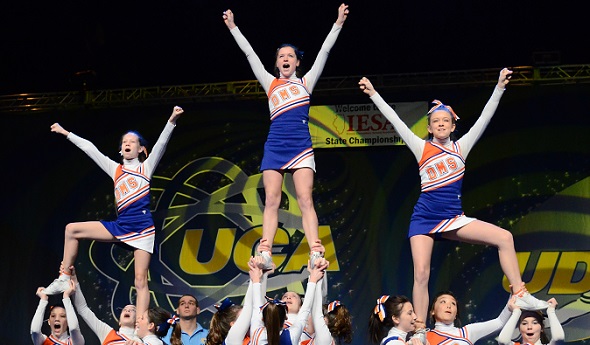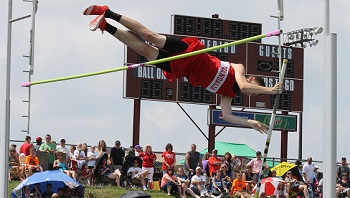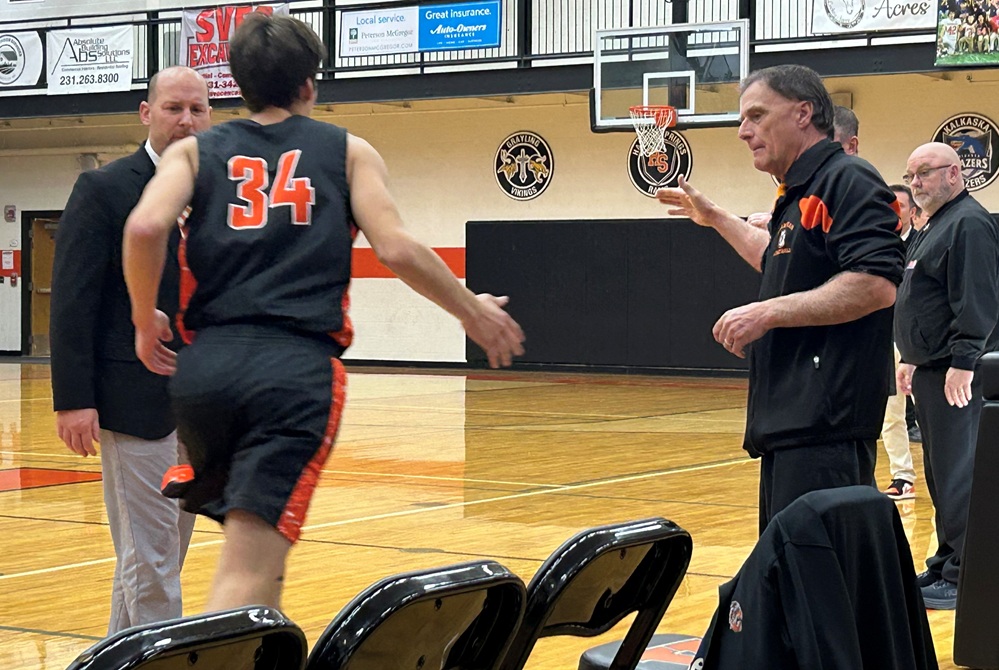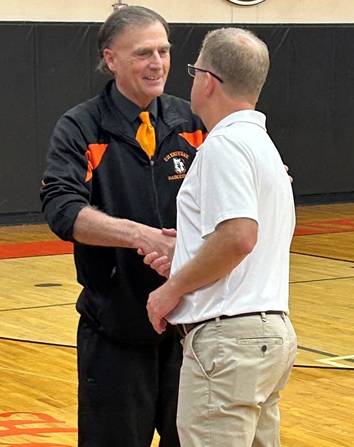
A League of Their Own in Illinois
May 20, 2014
By Rob Kaminski
MHSAA benchmarks editor
Imagine the scene: thousands of spectators roaring their approval as hundreds of cross country runners hit the finish line. A couple thousand others cascade applause on the wrestling mats as referees raise the hands of 19 champions.
Now, here’s the kicker, imagine this is taking place during postseason play for junior high/middle school student-athletes.
Again, that’s postseason, and junior high/middle school.
 “I guess when you see a kid cross the finish line in first place and 5,000 people are cheering, or watch a student run a race, throw the shot, or pole vault in front of that many at our track & field series, the proof is in the pudding,” said Steve Endsley, executive director of the Illinois Elementary School Association.
“I guess when you see a kid cross the finish line in first place and 5,000 people are cheering, or watch a student run a race, throw the shot, or pole vault in front of that many at our track & field series, the proof is in the pudding,” said Steve Endsley, executive director of the Illinois Elementary School Association.
“The environment, the feedback we get; it’s the greatest thing in the world to some who experience our tournaments. But, I temper that in saying this is not the Olympics, the pros, or even high school. Success at our level doesn’t guarantee future success. We want you to do your best, we want to prepare you to do your best, but understand this is junior high.”
If understanding that is difficult for some athletes and parents involved in IESA athletics, it’s also a foreign language to state high school associations across the country. The IESA is the only organization in America which exclusively governs interscholastic activities for grade levels 7-8.
Most states include junior high/middle schools in their rules and regulations, but few, if any, conduct tournaments.
“We’ve been doing it for so long, it’s accepted. Schools know that at the end of the regular season, they enter Regional play. The payoff is we have state series, a culminating activity, and it’s a good thing that’s going on,” Endsley said.
From the organization’s first postseason event in 1930 during which boys basketball tournaments took place in a lightweight (boys less than 100 pounds) and a heavyweight division, the IESA has grown to sponsoring more than 20 boys and girls activities.
 Measures have been taken in recent years to alleviate travel concerns at the end of the season. The IESA has added classifications in some sports, while keeping the number of teams which advance to the Finals the same. So, for instance, where 16 teams might have gone to two different sites in the past, now four different sites host eight schools.
Measures have been taken in recent years to alleviate travel concerns at the end of the season. The IESA has added classifications in some sports, while keeping the number of teams which advance to the Finals the same. So, for instance, where 16 teams might have gone to two different sites in the past, now four different sites host eight schools.
Admittedly, Endsley adds that the tournament series might add to some competitiveness, but since all schools enter the tournament, there might be less emphasis on winning during the regular season, and thus, heightened participation for those of all skill levels.
“If you don’t want the win-at-all-cost mentality, then step up to the plate at your member school and handle it that way,” Endsley said.
The refrain from association leaders around the country is that success in conveying the values and ideals of school sports is totally dependent on those in charge at the local level. Beginning with the 2012-13 school year, the IESA put more of that load squarely on the individual schools by making it a local decision as to whether students could participate with the school team and a club team in the same sport during the same season.
“From an association standpoint, it seemed like only people we were penalizing when had the limitations were the honest schools which self-reported,” Endsley said. “It was difficult to penalize those schools while everyone else knew the school down the street didn’t report.
“In a perfect world, the participation rule would be in place. But, it’s not a perfect world. Club sports schedule in accordance with high school seasons, but disregard our level when it comes to non-school activity. It’s year-round. So it’s practically impossible to equitably enforce it from a state level.”
There are more than 800 member schools in the IESA, which is an affiliate member of the National Federation of State High School Associations, but a separate entity from the Illinois High School Association.
Endsley estimates the IESA comprises 50-60 percent of eligible schools in Illinois, bolstered by unique membership options which differ from the IHSA and many state associations.
“We offer a la carte membership. A school can offer activities and maybe not participate in our state series. It’s only in those activities in which schools participate in the IESA state series that they must abide by our rules and regulations. Schools want some control. I think a la carte way is the way to go.
“If they join the IESA for one sport, they receive all mailings and information, so maybe one sport gets them in, but they may later add activities. If they are not a member, they don’t know about us.”
Yet, while separate bodies, the IESA and IHSA work hand-in-hand in many respects since nearly 100 percent of the IESA’s students will matriculate into IHSA schools.
“We attend the IHSA activity advisory meetings so we can keep a finger on the pulse of topics they are discussing and items they are considering. From the student standpoint, we will take our champions and introduce them in ceremonies at the IHSA Finals when our calendars line up,” Endsley said. “They get tickets, halftime introductions, pictures in the program, and it’s well-received recognition.”
Such activities are possible because the IESA seasons are different than the IHSA’s in some sports, or end sooner. For instance, the IESA plays baseball and softball in the fall, so its champions are recognized at the IHSA Finals in the spring.
“These activities create exposure and help build interests and aspirations for our schools,” Endsley said. “It’s nice P.R. for both associations.”
Whether different seasons or same seasons, the multitude of events throughout Illinois provides ample opportunity for the state’s contest officials as well. That’s another area in which the IESA and IHSA work together.
“We don’t license officials in the IESA, but we require our schools to use IHSA officials,” Endsley said. “We get great cooperation from the IHSA, it’s a good situation for our schools, and it’s a really good thing for officials. There are always plenty of games, and new officials gain valuable experience.”
Now in the midst of its ninth decade, the IESA continues to expand, adding boys and girls bowling and golf to its roster of activities in 2011.
The Association sponsors athletics for 7th- and 8th-graders, but 5th- and 6th-graders enrolled in a member school may participate with 7th-and 8th-grade teams within that building without a waiver. If such students are in an elementary school which feeds a member school, waivers are necessary.

'Scott Hancock Court' Celebrates JV Coach's 50 Years Building Up Cheboygan Hoops
By
Tom Spencer
Special for MHSAA.com
December 19, 2025
It’s been a remarkable season so far for the Cheboygan boys basketball players and coaches.
 The undefeated varsity Chiefs are looking ahead to the new calendar year and their next opponent, Northern Shores Conference rival Elk Rapids. They also have the District tournament they’ll be hosting in February in their sights.
The undefeated varsity Chiefs are looking ahead to the new calendar year and their next opponent, Northern Shores Conference rival Elk Rapids. They also have the District tournament they’ll be hosting in February in their sights.
But Scott Hancock is already looking ahead to the classes of 2035, 2036, 2037 and 2038. And nobody can blame him.
Hancock, a 1976 graduate of Cheboygan, has no intentions of ending his coaching career soon. He’d like to make it long enough to coach his youngest grandson Lincoln Hancock, who is already playing youth basketball in Cheboygan.
And while the Chiefs are finding success this year with the foundation Hancock helped build, the veteran coach can’t help but dream about his youngest grandson playing at Cheboygan High School.
“As a kindergartner he’s in Saturday basketball, and he loves the game,” Hancock said. “God willing, I plan to be there for him.”
Hancock is his 50th season in Cheboygan program. He enjoyed the opportunity to coach his two sons Nick and Brian, both school record holders. He’s also enjoyed coaching his grandson, Landon Gahn, the Chiefs’ junior point guard. Gahn played junior varsity for Hancock his freshman year and moved up to the varsity his sophomore season.
All but two of Hancock’s season were spent as the JV coach. He took the varsity job on an interim basis when current Cheboygan varsity coach, Jason Friday, was playing for the Chiefs in the late 1990s.
On Dec. 9, the Chiefs officially named their home court the Scott Hancock Court. His family was on hand as well as current and former Northern Michigan coaches.
Hancock’s JV team lost that night to Alpena in overtime. The score was 50-50 when the fourth quarter buzzer sounded.
“Looking back, we should have just called the game at the end of regulation,” Hancock admitted. “I got a bunch of great kids this year. and it was a tough loss because it was an overtime loss.”
 It was the only loss the Chiefs’ JV team has encountered so far this year. But wins and losses are not the focus of Hancock’s level of the program.
It was the only loss the Chiefs’ JV team has encountered so far this year. But wins and losses are not the focus of Hancock’s level of the program.
“I don't get too carried away with the wins and losses — I know what I'm there for,” Hancock explained. “I'm there to teach the kids to get them ready for the varsity.”
Hancock is considered by many to be the best coach in Cheboygan history. No counter argument can be found among the current varsity players and their head coach.
“He's the best coach that I've ever had — no bias because he's my grandfather,” acknowledged Gahn, who was found cheering from the bench as the Chiefs secured the victory earlier this week at Kingsley. “He teaches everything about basketball, but he doesn't really preach as much as he demonstrates being a good person. Just looking at him and what he does every day, you can just tell he's the guy that's doing everything right, even though nobody's watching.”
Senior Carson Kiefer helped lead the way for Cheboygan's varsity at Kingsley. He scored 12 points, with two 3-pointers. Kiefer credits Hancock for helping him improve his confidence on the court.
“I think he cares more about the person individually outside of sports,” said Kiefer, who is averaging 16 points per game. “It's fitting that he's a JV basketball coach, helping build players’ skills and confidence.”
Kiefer’s twin brother, Andrew, singled out Hancock’s commitment to the school.
“He's not just a school figure,” said Andrew Kiefer, who is averaging just under 12 points per game. “He is not just the coach. He is a community guy all-around.”
The Chiefs varsity is getting strong contributions from their juniors this season. Nolan Schley is averaging 12 points per game, and he’s second on the team in rebounding. And Gavin Smith is leading the team in rebounds and assists, collecting almost 10 boards and four dishes per game.
The Kiefers, Smith and Schley are part of the reason Friday is not surprised by the 6-0 start and seeking a District title for the first time since 2015. The last time Cheboygan won a conference championship was 2020, playing in the Straits Area Conference during Friday’s first season as boys head coach after previously coaching the girls varsity.
 “We knew that our junior and senior classes had some talent in there,” Friday noted. “The boys really want to win a District championship, as well as a conference championship. The boys put a ton of time in the offseason to do everything they can to get over that hump and get both a conference and District championship.”
“We knew that our junior and senior classes had some talent in there,” Friday noted. “The boys really want to win a District championship, as well as a conference championship. The boys put a ton of time in the offseason to do everything they can to get over that hump and get both a conference and District championship.”
Cheboygan will host a Division 2 District tournament this season after falling 50-48 in last year’s Division 3 District Final – also at home. The Chiefs face a field including league foes Grayling, Kalkaska and Kingsley as well as Ogemaw Heights and Sault Ste. Marie. Cheboygan topped the Sault 67-43 earlier this year and will play a home-and-home series with Grayling in January.
For now, though, the Chiefs are thinking only about Elk Rapids. Cheboygan started 7-0 last year before falling to the Elks to start the new year.
“We're approaching 7-0 again, so having them coming up here on the schedule, we’re definitely going to be practicing a little harder and watching maybe a little more film and just preparing for the game more seriously,” Gahn said. “Coach Friday was saying last year that he can't remember the last time the team started off 8-0, and it was our eighth game that we lost to Elks. So we're hoping to beat them next time we play.”
The court naming did not come as a surprise to Hancock. He was informed in a meeting with Marty Mix, Cheboygan principal. He thought he had some papers to sign and was surprised his family was waiting in the office.
“He was completely shocked, and Coach Hancock doesn't like attention,” said Friday, who is also the school’s athletic director and was in the notification meeting. “Scott always likes to be in the background, and he handled it quite well.”
And while his signature was placed on the court opening day this year, he points out the Hancock legacy started way before him.
“I'm more proud of the Hancock name on there more than the Scott part of it,” said Hancock, who also serves as the city’s as the parks and recreation director. “Believe me, my dad was a Chief through and through. He passed in 2006. I know he was there in spirit with us looking down.”
 Tom Spencer is a longtime MHSAA-registered basketball and soccer official, and former softball and baseball official, and he also has coached in the northern Lower Peninsula area. He previously has written for the Saginaw News, Bay County Sports Page and Midland Daily News. He can be reached at [email protected] with story ideas for Manistee, Wexford, Missaukee, Roscommon, Ogemaw, Iosco, Alcona, Oscoda, Crawford, Kalkaska, Grand Traverse, Benzie, Leelanau, Antrim, Otsego, Montmorency, Alpena, Presque Isle, Cheboygan, Charlevoix and Emmet counties.
Tom Spencer is a longtime MHSAA-registered basketball and soccer official, and former softball and baseball official, and he also has coached in the northern Lower Peninsula area. He previously has written for the Saginaw News, Bay County Sports Page and Midland Daily News. He can be reached at [email protected] with story ideas for Manistee, Wexford, Missaukee, Roscommon, Ogemaw, Iosco, Alcona, Oscoda, Crawford, Kalkaska, Grand Traverse, Benzie, Leelanau, Antrim, Otsego, Montmorency, Alpena, Presque Isle, Cheboygan, Charlevoix and Emmet counties.
PHOTOS (Top) Longtime Cheboygan boys basketball JV coach Scott Hancock sends a starter onto the floor during introductions before a game against Kingsley. (Middle) The Hancock family takes a photo with Scott’s newly-added signature on the floor. From left: Landon Gahn, Brian Hancock, Olwyn Hancock, Scott Hancock, Marjean Hancock, Lincoln Hancock and Nick Hancock. (Below) Scott Hancock shakes hands with a Kingsley assistant coach. (Family photo courtesy of Chris Murdick. Other photos by Tom Spencer.)

